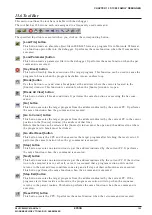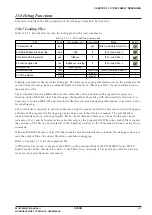
CHAPTER 13 S1C88 FAMILY DEBUGGER
S5U1C88000C MANUAL II
EPSON
117
WORKBENCH/DEV TOOLS/OLD ASSEMBLER
Single-stepping
(1) Types of single-stepping
There are three types of single-stepping available:
• Single-stepping C statements or instructions (STEP)
In C source display mode, the program is single-stepped, one C source line at a time. In disas-
semble display or mix display mode, the program is single-stepped, one instruction at a time.
• Single-stepping other than functions or subroutines (NEXT)
In C source display mode, function calls in the program currently being executed are skipped by
handling each function call from entry until the return simply as a single step. Other program
parts are single-stepped in the same way as for STEP.
In disassemble display or mix display mode, the cars, carl, call, and int instructions till returned to
the next step by a return instruction are executed as a single step. Other instructions are singled-
stepped in the same way as for STEP.
• Terminating at a function or subroutine (STEP EXIT)
In C source display mode, the program is successively executed from the current function until it
returns to the higher-level function, and is halted after returning. Do not run this single-stepping
mode in the main function.
In disassemble display or mix display mode, the program is successively executed from the
current subroutine until it is returned to the higher-level subroutine by a return instruction, and is
halted after returning. At the highest level, the program is executed in the same way as when run
by the g command. If a lower-level subroutine is called, and returned from it, the program execu-
tion is not halted.
In either case, the program starts executing from the current PC.
Table 13.8.4.2 Commands/menu items/tool bar buttons for single-stepping
Function
Stepping
Stepping except functions/subroutines
Exit from function/subroutine
Command
s
n
se
Button
Menu
[Run | Step]
[Run | Next]
[Run | Step Exit]
When executing s or n by command input, the number of steps to be executed can be specified, up to
65,535 steps. When using menu commands or tool bar buttons, the program is executed one step at a
time.
In the following cases, single-stepping is terminated before a specified number of steps is executed:
• The [Key Break] button is clicked, the [Run | Stop] menu command is selected or the [Esc] key is
pressed.
• A program execution error is detected.
Single-stepping is not suspended by breaks set by the user such as a PC break or data break.
[Key Break] button
∗
When the program does not stop, use this button to forcibly stop it.
(2) Display during single-stepping
In the initial debugger settings, the display is updated as follows:
When the [Source], [Register], [Dump], [Trace], or [Watch] window is open, the display contents are
updated after the last step has been executed. If the [Register] window is closed, its contents are
displayed in the [Command] window.
The [Symbol ] and [Coverage] windows do not change their display contents due to single-stepping.















































